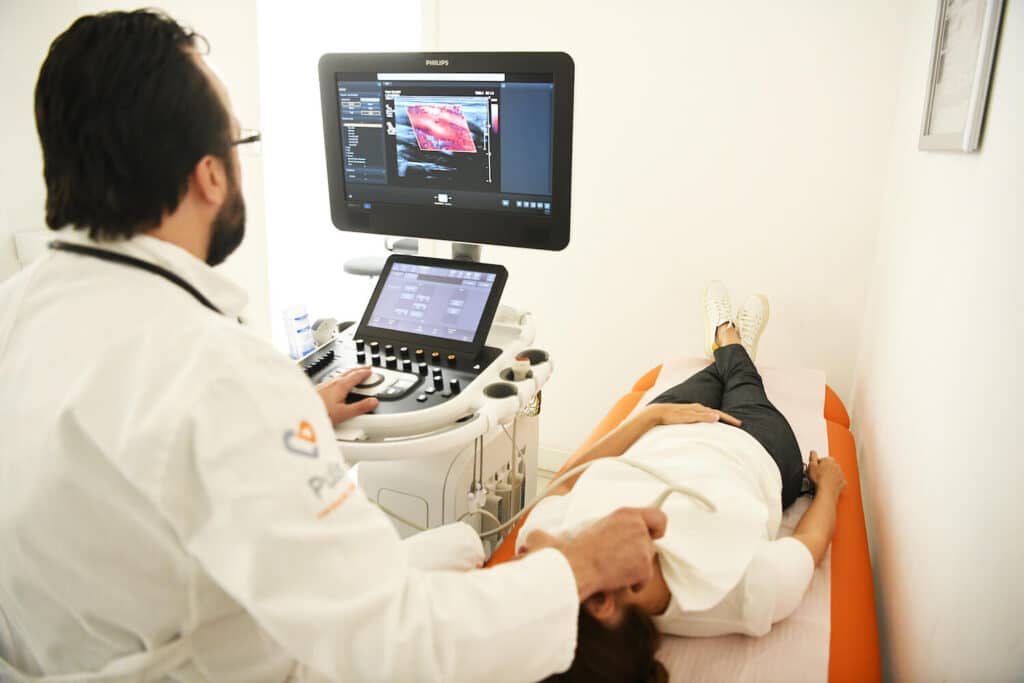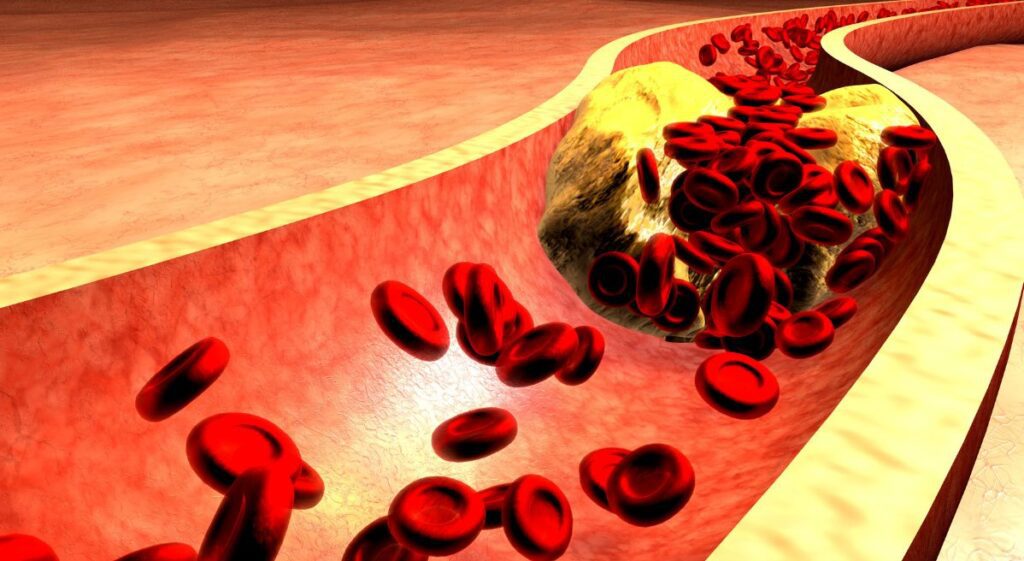Home » Services » Ultrasound (Ultrasound Diagnostics) » Doppler of the Neck Blood Vessels
Doppler of the Neck Blood Vessels
What is neck blood vessels doppler?
Neck Doppler is a non-invasive diagnostic test used to assess blood flow through the blood vessels in the neck area. This test is often called “Doppler ultrasound of the neck” or “Doppler of the carotid arteries.”
Why should you have Doppler of the neck blood vessels?
- People who have symptoms such as dizziness, fainting, speech problems, loss of balance, or other neurological symptoms that may indicate vascular problems in the neck may be referred for a Doppler ultrasound of the neck to detect possible blood flow problems.
- Hardening of the arteries or atherosclerosis is a condition in which plaque (accumulation of fatty substances, calcium and other substances) accumulates on the inner walls of the arteries, narrowing the passage through which blood flows. Doppler of the blood vessels of the neck can help detect plaques and assess the degree of narrowing of the arteries.
- High cholesterol means that a person has elevated levels of total cholesterol in the blood, especially “bad” LDL cholesterol. High cholesterol is a risk factor for the development of atherosclerosis, which reduces blood flow and increases the risk of heart attacks and strokes.
- People with diabetes have an increased risk of atherosclerosis. Neck Color Doppler is used to assess blood flow through the carotid arteries. In people with diabetes, this test can be useful for monitoring the condition of the carotid arteries and detecting any changes or narrowing that could increase the risk of stroke.
- High blood pressure (hypertension) can be a risk for carotid artery disease (CAD). High blood pressure can lead to atherosclerosis and can increase the risk of plaque rupture in the carotid arteries. When the plaque ruptures, it can lead to the formation of a blood clot, which can block an artery and cause a stroke.
- • If an unusual sound is heard with a stethoscope in the carotid arteries, it is caused by turbulent blood flow. This means that blood flows through narrowed or blocked arteries, creating irregular flow and an audible noise.
- • When a person experiences a transient ischemic attack (TIA) or stroke, color Doppler can be used to detect potential narrowing or blockages in the blood vessels of the neck that may have caused the stroke.
- • If there is a family history of stroke or heart disease, Doppler ultrasound of the neck can help identify people who are at higher risk of these complications so that preventive measures can be taken.
- • Color Doppler can also be used to detect and monitor aneurysms (enlargements) in the blood vessels of the neck.
- • If a person has already been diagnosed with narrowing of the arteries or other vascular problems, a Doppler of the blood vessels of the neck can be used to monitor the condition over time or to evaluate the effectiveness of the applied treatment.
What conditions and diseases can be identified by color doppler of the blood vessels of the neck?
- Check the blood flow through the artery after surgery. Carotid endarterectomy is a surgical procedure used to remove plaque (atherosclerotic deposits) that accumulates on the inner wall of the carotid artery. It is performed in people who have significant narrowing of the carotid arteries and/or have already suffered a transient ischemic attack (TIA) or stroke caused by embolization from the carotid arteries. This procedure can reduce the risk of another stroke in some patients.
- For certain patients, it is possible to use minimally invasive techniques, such as carotid artery stenting, to improve blood flow and reduce the risk of stroke. Color Doppler can be used to check stent placement and effectiveness
- Color Doppler can reveal the presence of a thrombus (blood clot) in the carotid arteries. A thrombus can form inside an artery or it can be an embolus (blood clot) that travels from another part of the body to the carotid arteries.
- Carotid artery disease (CAD) refers to a condition in which the carotid arteries are narrowed due to atherosclerosis. If plaques form in these arteries, the risk of stroke increases. A stroke can occur when a clot from the carotid arteries breaks off and blocks smaller blood vessels in the brain.
- Carotid dissection is a condition in which the inner layer of the carotid artery separates from the outer layer due to a rupture of the artery wall. This can lead to the formation of a blood clot that can block an artery and cause a stroke. Color Doppler is used to detect abnormal blood flow and dissection in the carotid arteries.
- Arteriovenous fistulas are abnormal connections between arteries and veins in the neck that can cause disruption of normal blood flow. Color Doppler helps detect these fistulas and assess their effect on the circulation.
- Aneurysms are enlargements or protrusions of arteries that can be dangerous because they can rupture and cause serious complications. Color Doppler is used to visualize aneurysms and monitor their growth and condition.
- Numerous studies have shown that by measuring the thickness of the carotid artery and evaluating the characteristics of the plaque, it is possible to predict the presence of coronary heart disease and the increased possibility of a heart attack or stroke.
- During aortic valve surgery, blood flow in the carotid artery is monitored using color Doppler ultrasound, which can be of great importance in order to prevent possible complications related to blood flow to the brain.
How should you prepare for color doppler neck blood vessels?
- Before the test, be sure to inform your doctor about all the medicines you take regularly. Some substances in medicines can affect blood flow, so the doctor may recommend that you temporarily stop taking certain medicines before the test.
- Clothing on the upper body, especially around the neck, should be easily removed to facilitate access to the neck during the test.
- Before the test, remove all jewelry around the neck and upper body, as it could interfere with the placement of the ultrasound probe.
- • If you smoke, try to avoid smoking right before the test, as nicotine can affect blood flow.
- • If you have any health problems or symptoms that could affect the test, tell your doctor before the test.

What can you expect during a color doppler examination of the vessels of the neck?
How long does the color doppler of the blood vessels of the neck take?
- If more blood vessels need to be examined or different regions of the neck need to be analyzed in detail, the examination may take longer.
- Sometimes the anatomy of blood vessels can be complex and require more time for accurate visualization and analysis.
- In some cases, technical challenges such as a poor acoustic window (eg due to excessive neck thickness or the presence of fatty tissue) may prolong the duration of the examination.
- If abnormalities or problems are detected during the examination, additional measurements and imaging may be necessary to assess the condition of the blood vessels in more detail.
- Patient cooperation during the examination can also affect the duration. If the patient is calm and cooperative, the examination can go faster.

What does the procedure for performing a color doppler of the blood vessels of the neck look like?
- The patient will be called to the ultrasound room, where he will be asked to remove jewelry and clothing on the upper body to free the neck. If necessary, the patient will be provided with a better gown or gown for privacy.
- The patient will be placed in a supine position on a bed or examination table. The technician will place a pillow under the head to ensure comfort and better exposure of the neck.
- The technician will apply the gel to the area of the neck to be examined. The gel helps ensure better conduction of ultrasound waves between the skin and the ultrasound probe.
- The technician will carefully place the ultrasound probe on the area of the neck to be examined. The probe emits high-frequency sound waves into the blood vessels, and at the same time receives the reflected waves, which makes it possible to create real-time images of blood flow.
- Images of blood vessels in the neck will be displayed on the monitor, and blood flow will be shown by color coding, where different colors are used to show the direction and speed of blood flow.
- The technician will record and measure the blood flow through the various blood vessels of the neck. This includes assessment of flow rate, flow direction, presence of plaque or other potential abnormalities.
- After the examination is completed, the technician will wipe the gel from the patient’s skin. The images and results of the examination will be saved and forwarded to the doctor who will analyze them and give a diagnosis.
Who will review the color doppler results of the blood vessels of the neck?
What can color doppler blood vessels of the neck discover?
Narrowing of the arteries
Arterial Blockages
Atherosclerosis
Aneurysms
Blood flow in the carotid arteries
Blood flow in other blood vessels of the neck
Effect of treatment:

What are the additional tests that should be done based on the color doppler results of the blood vessels of the neck?
CT (Computed Tomography) or MRI (Magnetic Resonance Imaging)
These tests provide more detailed images of the blood vessels and internal structures of the neck and brain. CT and MRI can detect narrowings, blockages, aneurysms or other vascular changes with high resolution.
Angiography
Angiography uses X-rays and a contrast medium to visualize blood vessels and precisely map any narrowing or blockages. This test can be done through traditional angiography or non-invasive CT or MR angiography.
Additional blood tests:
Coagulation tests
EKG (electrocardiogram)
Examination of other vascular regions
The color doppler of the blood vessels of the neck – price
The price of this kind of exam is 6900 RSD.
